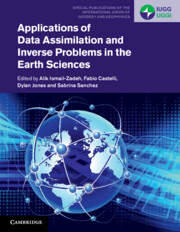Book contents
- Applications of Data Assimilation and Inverse Problems in the Earth Sciences
- Series page
- Applications of Data Assimilation and Inverse Problems in the Earth Sciences
- Copyright page
- Contents
- Contributors
- Preface
- Acknowledgements
- Part I Introduction
- Part II ‘Fluid’ Earth Applications: From the Surface to the Space
- Part III ‘Solid’ Earth Applications: From the Surface to the Core
- 11 Trans-Dimensional Markov Chain Monte Carlo Methods Applied to Geochronology and Thermochronology
- 12 Inverse Problems in Lava Dynamics
- 13 Data Assimilation for Real-Time Shake-Mapping and Prediction of Ground Shaking in Earthquake Early Warning
- 14 Global Seismic Tomography Using Time Domain Waveform Inversion
- 15 Solving Larger Seismic Inverse Problems with Smarter Methods
- 16 Joint and Constrained Inversion as Hypothesis Testing Tools
- 17 Crustal Structure and Moho Depth in the Tibetan Plateau from Inverse Modelling of Gravity Data
- 18 Geodetic Inversions and Applications in Geodynamics
- 19 Data Assimilation in Geodynamics: Methods and Applications
- 20 Geodynamic Data Assimilation: Techniques and Observables to Construct and Constrain Time-Dependent Earth Models
- 21 Understanding and Predicting Geomagnetic Secular Variation via Data Assimilation
- 22 Pointwise and Spectral Observations in Geomagnetic Data Assimilation: The Importance of Localization
- Index
- References
20 - Geodynamic Data Assimilation: Techniques and Observables to Construct and Constrain Time-Dependent Earth Models
from Part III - ‘Solid’ Earth Applications: From the Surface to the Core
Published online by Cambridge University Press: 20 June 2023
- Applications of Data Assimilation and Inverse Problems in the Earth Sciences
- Series page
- Applications of Data Assimilation and Inverse Problems in the Earth Sciences
- Copyright page
- Contents
- Contributors
- Preface
- Acknowledgements
- Part I Introduction
- Part II ‘Fluid’ Earth Applications: From the Surface to the Space
- Part III ‘Solid’ Earth Applications: From the Surface to the Core
- 11 Trans-Dimensional Markov Chain Monte Carlo Methods Applied to Geochronology and Thermochronology
- 12 Inverse Problems in Lava Dynamics
- 13 Data Assimilation for Real-Time Shake-Mapping and Prediction of Ground Shaking in Earthquake Early Warning
- 14 Global Seismic Tomography Using Time Domain Waveform Inversion
- 15 Solving Larger Seismic Inverse Problems with Smarter Methods
- 16 Joint and Constrained Inversion as Hypothesis Testing Tools
- 17 Crustal Structure and Moho Depth in the Tibetan Plateau from Inverse Modelling of Gravity Data
- 18 Geodetic Inversions and Applications in Geodynamics
- 19 Data Assimilation in Geodynamics: Methods and Applications
- 20 Geodynamic Data Assimilation: Techniques and Observables to Construct and Constrain Time-Dependent Earth Models
- 21 Understanding and Predicting Geomagnetic Secular Variation via Data Assimilation
- 22 Pointwise and Spectral Observations in Geomagnetic Data Assimilation: The Importance of Localization
- Index
- References
Summary
Abstract: Variational data assimilation through the adjoint method is a powerful emerging technique in geodynamics. It allows one to retrodict past states of the Earth’s mantle as optimal flow histories relative to the current state, so that poorly known mantle flow parameters such as rheology and composition can be tested explicitly against observations gleaned from the geologic record. By yielding testable time dependent Earth models, the technique links observations from seismology, geology, mineral physics, and paleomagnetism in a dynamically consistent way, greatly enhancing our understanding of the solid Earth system. It motivates three research fronts. The first is computational, because the iterative nature of the technique combined with the need of Earth models for high spatial and temporal resolution classifies the task as a grand challenge problem at the level of exa-scale computing. The second is seismological, because the seismic mantle state estimate provides key input information for retrodictions, but entails substantial uncertainties. This calls for efforts to construct 3D reference and collaborative seismic models, and to account for seismic data uncertainties. The third is geological, because retrodictions necessarily use simplified Earth models and noisy input data. Synthetic tests show that retrodictions always reduce the final state misfit, regardless of model and data error. So the quality of any retrodiction must be assessed by geological constraints on past mantle flow. Horizontal surface velocities are an input rather than an output of the retrodiction problem; but viable retrodiction tests can be linked to estimates of vertical lithosphere motion induced by mantle convective stresses.
Keywords
- Type
- Chapter
- Information
- Publisher: Cambridge University PressPrint publication year: 2023
References
- 1
- Cited by

